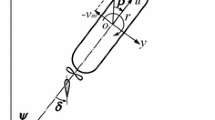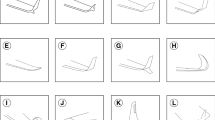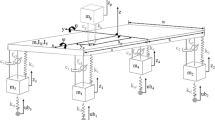Abstract
The time derivative of acceleration is called a jerk, which is an important property to evaluate ride comfort in elevators, cars, and so on. Likewise, evaluation of motion sickness or ride comfort on a vessel could be achieved by this jerk property in the future. In this paper, we utilize the PDF Line Integral Method (PLIM), which was newly contrived in our previous research, for calculating not only roll angular acceleration but also roll angular jerk. The derivation of this theory, as well as numerical comparison with Monte Carlo simulation (MCS) results, are presented. Although the utilized restoring curve (GZ curve) exhibits strong asymmetricity, the proposed method successfully calculates roll angular jerk for such a condition. Since roll angular jerk is a high-order differential property, the biggest advantage of PLIM is that it only requires the information of roll and roll rate joint probability density function (PDF) to provide the PDF of jerk.










Similar content being viewed by others
References
Visser M (2003) Jerk, snap, and the cosmological equation of state. Class Quantum Gravity 21(11):15
(1993) Elevator start jerk removal. United States Patent—5424498
Hoberock LL (1976) A survey of longitudinal acceleration comfort studied in ground transportation vehicle. Research report 40, The Council for Advanced Transportation Studies
Zhu WQ (1988) Stochastic averaging methods in random vibration. Appl Mech Rev 41(5):189–199
Cai GQ (1995) Random vibration of nonlinear system under nonwhite excitations. J Eng Mech 121(5):633–639
Naess A (1996) A second-order theory for the response statistics of wave induced ship hull vibrations in random seas. Mar Struct 9(3–4):389–408
Roberts JB, Spanos PD (2003) Random vibration and statistical linearization. Dover Civil and Mechanical Engineering
Kougioumtzoglou A, Spanos PD (2014) Stochastic response analysis of the softening Duffing oscillator and ship capsizing probability determination via a numerical path integral approach. Probab Eng Mech 35:67–74
Namachchivaya NS (2016) Random dynamical systems: addressing uncertainty, nonlinearity and predictability. Meccanica 51:2975–2995
Maki A, Dostal L, Maruyama Y, Sakai M, Sugimoto K, Fukumoto Y, Umeda N (2020) Theoretical estimation of roll acceleration in beam seas using PDF line integral method. J Mar Sci Technol. https://doi.org/10.1007/s00773-020-00770-1
Haddara MR (1974) A modified approach for the application of Fokker-Plank equation to the nonlinear ship motion in random waves. Int Shipbuild Prog 21(242):283–288
Roberts JB (1982) A stochastic theory for nonlinear ship rolling in irregular seas. J Ship Res 26(4):229–245
Roberts JB, Vasta M (2000) Markov modeling and stochastic identification for nonlinear ship rolling in random waves. Philos Trans R Soc Lond Ser A 358:1917–1941
Francescutto A, Naito S (2004) Large amplitude rolling in a realistic sea. Int Shipbuild Prog 51(2, 3):221–235
Su Z, Falzarano JM (2011) Gaussian and non-Gaussian cumulant neglect application to large amplitude rolling in random waves. Int Shipbuild Prog 58:97–113
Chai W, Naess A, Leira BJ (2015) Stochastic dynamic analysis and reliability of a vessel rolling in random beam seas. J Ship Res 59(2):113–131
Belenky VL, Glozter D, Pipiras V, Sapsis TP (2019) Distribution tail structure and extreme value analysis of constrained piecewise linear oscillators. Probab Eng Mech 57:1–13
Anastopoulos PA, Spyrou KJ (2019) Can the generalized Pareto Distribution be useful towards developing ship stability criteria?. In: International ship stability workshop
Dostal L, Kreuzer E, Namachchivaya NS (2012) Non-standard stochastic averaging of large-amplitude ship rolling in random seas. Proc R Soc Lond A Math Phys Eng Sci 468:4146–4173
Dostal L, Kreuzer E (2014) Assessment of extreme rolling of ships in random seas. In: ASME 2014 33rd International conference on ocean, offshore and arctic engineering. American Society of Mechanical Engineers
Maki A (2017) Estimation method of the capsizing probability in irregular beam seas using non-gaussian probability density function. J Mar Sci Technol 22(2):351–360
Maki A, Sakai M, Umeda N (2019) Estimating a non-gaussian probability density of the rolling motion in irregular beam seas. J Mar Sci Technol 24:1071–1077
To CWS (2017) Nonlinear random vibration: analytical techniques and applications, 2nd edn. CRC Press
Sakata K, Kimura K (1979) The use of moment equations for calculating the mean square response of a linear system to non-stationary random excitation. J Sound Vib 67(3):383–393
Sakata K, Kimura K (1980) Calculation of the non-stationary mean square response of a non-linear system subjected to non-white excitation. J Sound Vib 73(3):333–343
Kimura K (1995) Non-Gaussian equivalent linearization for estimation of stochastic response distribution of nonlinear systems. Trans Jpn Soc Mech Eng Ser C 61(583):831–835 (in Japanese)
Kimura K, Sakata M (1980) Non-stationary responses of a non-symmetric non-linear system subjected to a wide class of random excitation. J Sound Vib 76(2):261–272
Kimura K, Takahara K, Yamamoto S (2000) Estimation of non-gaussian response distribution of a system with nonlinear damping. In: Dynamics and design conference (in Japanese)
Papoulis A, Pillai SU (2002) Probability, random variables and stochastic processes, 4th edn. McGraw-Hill
Acknowledgements
We are grateful to Dr. Munehiko Minoura of Osaka University and Prof. Toru Katayama of Osaka Prefecture University for their technical advice and discussions. This work was supported by a Grant-in-Aid for Scientific Research from the Japan Society for Promotion of Science (JSPS KAKENHI Grant Number 19H02360) as well as the collaborative research program/financial support from the Japan Society of Naval Architects and Ocean Engineers. Further, part of the research was conducted as collaborative research with ClassNK.
Author information
Authors and Affiliations
Corresponding author
Additional information
Publisher's Note
Springer Nature remains neutral with regard to jurisdictional claims in published maps and institutional affiliations.
About this article
Cite this article
Maki, A., Dostal, L., Maruyama, Y. et al. Theoretical determination of roll angular jerk of ships in irregular beam seas using PDF line integral method. J Mar Sci Technol 27, 163–172 (2022). https://doi.org/10.1007/s00773-021-00823-z
Received:
Accepted:
Published:
Issue Date:
DOI: https://doi.org/10.1007/s00773-021-00823-z




